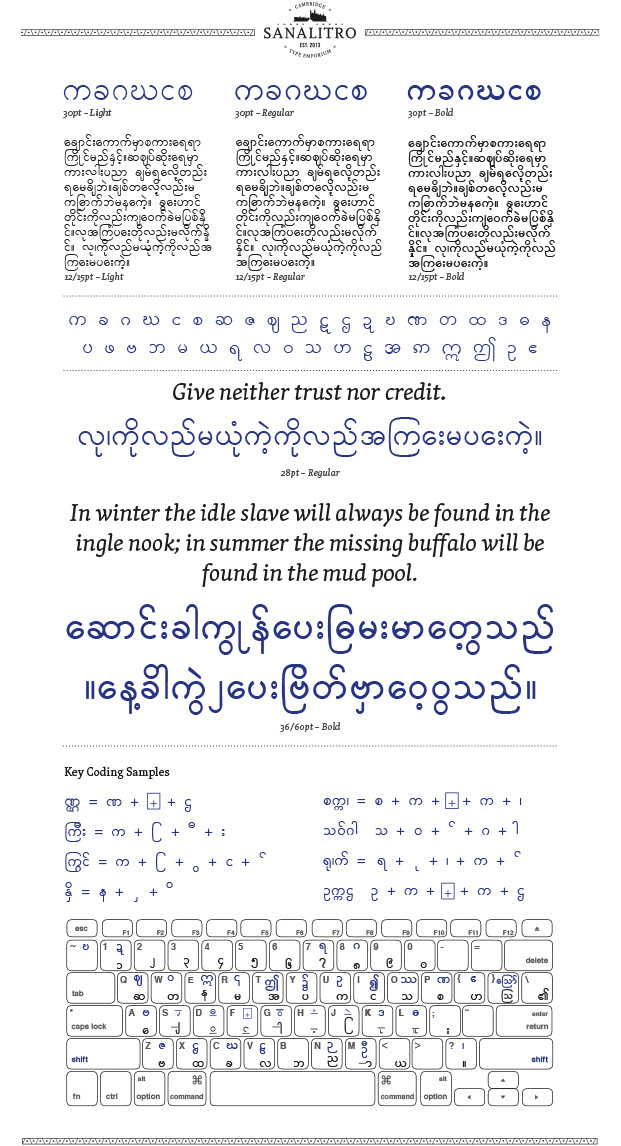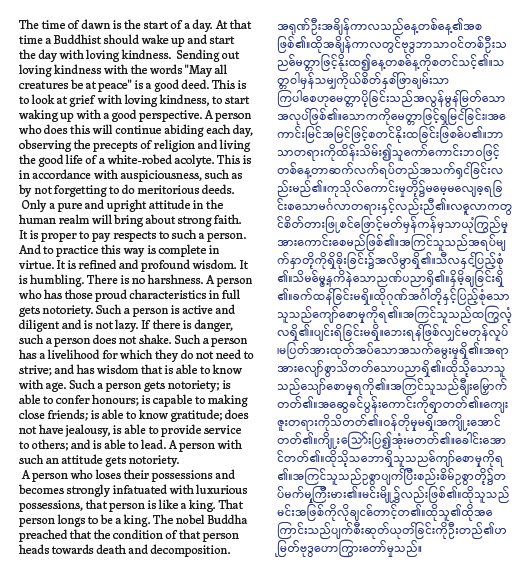
There is a region of southern Bangladesh called the Chittagong Hill Tracts. This upland and forested area is home to 13 different indigenous peoples, each of which has its own genetic identity, history and cultural traditions. Many have their own language and even their own script. All these languages and scripts are endangered.
The Marmas, sometimes referred to as the Mogh, live mostly in the Chittagong Hill Tracts. According to the Marma writer Kya Shai Pro, the word “Marma” is derived from the “Mryma” or “Mraima,” hinting at the Marma roots in Myanmar, or Burma. The Marmas are fair complexioned, with a nose that is slightly flat, showing similarities with the Burmese. The material culture of the Marma society includes many of the basic tools and weapons of primitive societies. According to the philologists, the Marma language belongs to the Burmese group of the Tibeto-Burman language family. The Marma alphabet, “Marmaza” or “Marimacha” originates from the ancient sub-continental Brahmi alphabet that had left-to-right writing style. It is known that the people of Krishna and Godabar areas of south India migrated to several areas of southeast Burma in the sixth century. The Marma tongue, then, is a dialect descended from the Burmese language. There are 45 letters in the Marma alphabet (33 consonants and 12 vowels), plus several alternative letters, 25 diacritic and punctuation marks, numerals 0-9 and glyphs that allow for stacked alphabet forms. The Marma script is an offshoot of the Burmese script, though there are several differences between the two, such as sound, and how some of the letters are used. The ST Marma Pro typeface currently comes in 3 weights containing all the above features.





ST Marma Pro is a 12 week development by Tom Sanalitro, of a 3 weight typeface family for the Marma writing system. It is aimed to be an improvement over his last ST Marma font by going beyond being just a one weight typeface where the letters are mono line based. Marma Pro takes into consideration the traditional form of the Marma letters by researching into the native users tools, materials and methods and then development into how these can be applied to the design of a typeface while maintaining typographic form and readability.
The Marma writing system is an endangered alphabet used by the Marma people, They are found in a Region of southern Bangladesh called the Chittagong Hill Tracts. This upland and forested area is home to 13 different indigenous peoples, each of which has its own genetic identity, history and cultural traditions. Many have their own language and even their own script. All these languages and scripts are endangered.
The Marmas, sometimes referred to as the Mogh, live mostly in the Chittagong Hill Tracts. They call themselves “Marma Lumya.” According to the Marma writer Kya Shai Pro, the word “Marma” is derived from the “Mryma” or “Mraima,” hinting at the Marma roots in Myanmar, or Burma.
They are the second largest ethic group in Bangladesh. According to the National Census of 1991, Bangladesh has a Marma Population of 1,57,301. The Marmas are fair complexioned, with a nose that is slightly flat. They show similarities with the Burmese. The material culture of the Marma society includes many of the basic tools and weapons of primitive societies. According to the philologists, the Marma language belongs to the Burmese group of the Tibeto-Burman language family. The Marma alphabet, “Marmaza” or “Marimacha” originates from the ancient sub-continental Brahmi alphabet that had left-to-right writing style. It is known that the people of Krishna and Godabar areas of south India migrated to several areas of southeast Burma in the sixth century. The Marma tongue, then, is a dialect descended from the Burmese language. Lewin has divided the whole of hill populations into two groups: one is “Khyoung tha” or “Khyoungsa” meaning “sons of a river” and the others “Toungtha” or “Toungsa” meaning “sons of a hill.” About their language, he says, “The Mugh (Marma) speak a provincial dialect of the Arakanese Language, which tongue was also parent stock of the modern Burmese language. The language has the strong affinities with the Himalayan and Tibetan dialects.”
*
There are 45 letters in the Marma alphabet (33 consonants and 12 vowels), plus several alternative letters, 25 diacritic and punctuation marks, numerals 0-9 and glyphs that allow for stacked alphabet forms. The Marma script is an offshoot of the Burmese script, though there are several differences between the two, such as sound, and how some of the letters are used. The ST Marma Pro typeface currently comes in 3 weights containing all the above features.
*
After some research I found several sources of Myanmar and Burma handwritten scripts. I decided the sources could be used for the development of my Marma typeface. The Sources showed a lot more flicks and curves than in all the previous examples I had found on the Marma script. These relied on the use of a geometric tool to create perfect lines and curves but the found scripts showed a real hand ons traditional approach that I wanted to incorporate into my new type designs.
These sources allowed me to pick design features like having a minimal amount of straight lines, thick and thins and the stress. The important part now was to be able to add these features and a traditional look to the typeface while maintaining some form of typographical understanding and awareness to the design.
For any further information please look up any of the following sites and contracts.
sanalitro.co.uk
endangeredalphabets.com
mothertonguebooks.org
uni.hilledu.com
scriptsource.org






